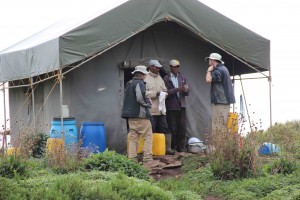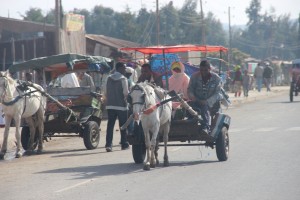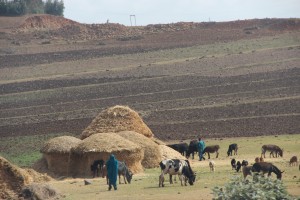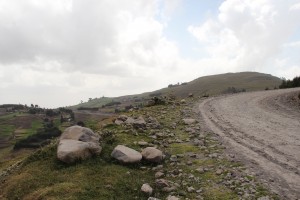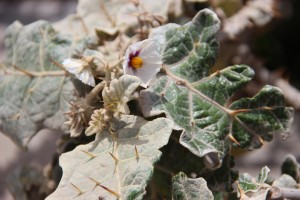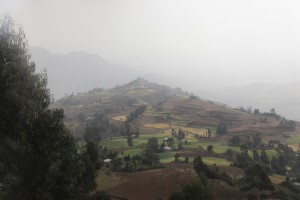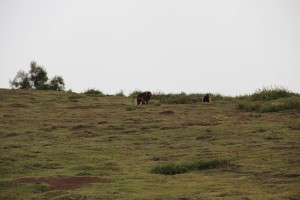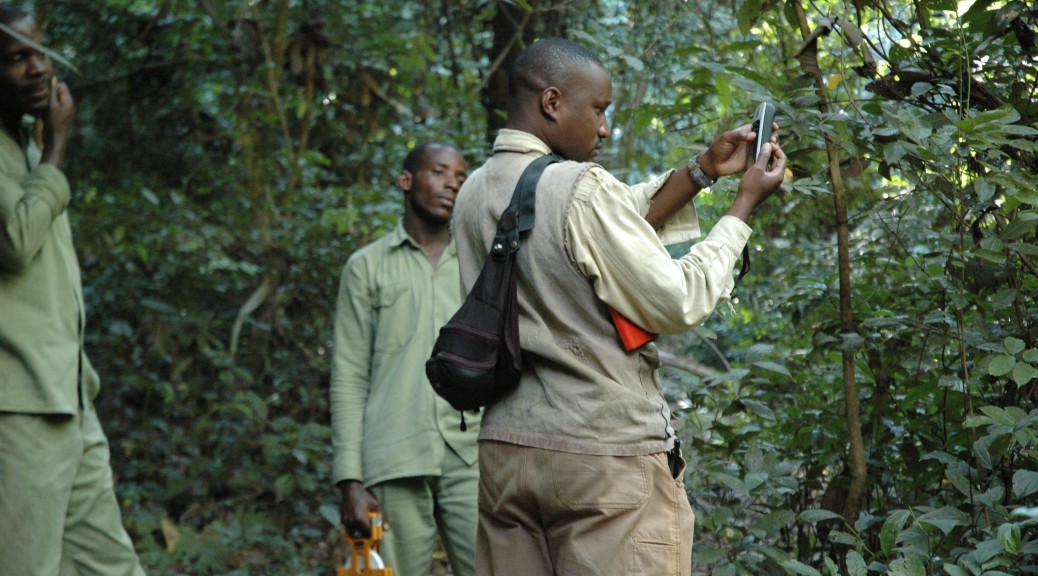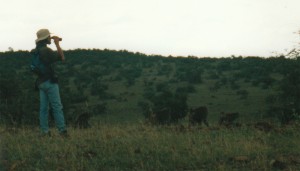20 June 2012
I woke up several times in the night, but I finally woke up to see dawn light filtering into the tent, instead of the pitch black of night. Used to studying chimpanzees, who often leave their night nests before dawn, I felt I had overslept. I unzipped the tent and went into the kitchen tent. Tyler was there heating water for tea and oatmeal. I thought everyone else must have already left for the monkeys. But no, as it turns out, geladas are lazy monkeys. As Taylor says, “they are solar powered.” They sleep on cliffs, and bask in the morning sun before climbing up to the grasslands above. Even then they may sit around socialize a while before starting the day’s main business: feeding.
The others came in one by one and fixed their breakfast and lunch. Unlike dinner, each person fixed their own breakfast and packed their own lunch, some more elaborate than others. Taylor eagerly prepared a sardine and salad sandwich from one of the five cans of sardines Tyler had bought for him in Addis. For our first day at Guassa, Tyler and I wouldn’t be going out all day, so we would come back for lunch.
It takes time for a body to adjust to 11,000 feet. There’s a lot less oxygen in the air. “I’m sucking wind just walking up the hill a bit,” Tyler commented ruefully.
The geladas had been spending a lot of time in the south of their range, but Tyler wanted me to see the north, with its spectacular views. So for our first day out, we went on a gentle hike, together with Peter. But even this left me winded. I stopped frequently to look at plants, take pictures and catch my breath.
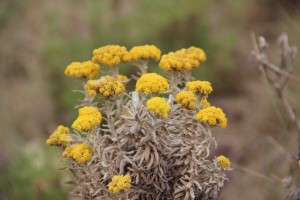
Up close, Guassa looks like a giant herb garden. Thyme covers much of the ground, along with Helichrysum, bushy little plants with silvery gray leaves and bright yellow flowers, and other low-growing plants: clover, daisies, dandelions, two kinds of carrots, an onion, and many others I didn’t recognize.

Occasional stands of giant lobelias made clear that we were in the African mountains. These odd herbs look a bit like Joshua trees. Peter says that the ones at Guassa grow until they flower and then die, to be replaced by clones of the original plants. I knew these plants from the books and magazine articles on mountain gorillas by George Schaller and Dian Fossey that first made me want to become a primatologist.
We walked along a path through flowers and herbs, through stands of giant lobelias and giant celery. I asked Peter what the strange bushy plant with scaly leaves, and he said it was heather – which just confirmed my impression that we had somehow ended up in Scotland by mistake.

I had imagined that above the cliffs where the geladas slept, the grassland would be a gently rolling plateau. There were some places like that, but for the most part, here the cliffs were topped with steep hills, including the one that we were walking along. It was a long way down. Peter and Tyler said it was too bad about all the haze; you could normally see much further. But it looked like we could see plenty far down as it was.
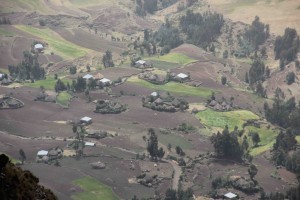
At one point where we stopped, Peter said it was about a full kilometer down to the valley bottom. I’ve been up to the observation decks of a few skyscrapers, but the tallest of these, the Sears Tower in Chicago, is just over 440 meters, less than half the height that we now stood above the valley. We looked down to fields and round farmhouses topped with conical thatched roofs, spread out like a map below us.
Tyler spotted gelada monkeys on the steep slope of a hill above the cliff across from us. It seemed impossible to get from here to there without falling off the hill into the abyss. But still we went – and for the most part, found that even though the hills looked impossibly steep, if you stepped the right way, you could get around.
We met the geladas at closer range as they came up the hill. They let us come close, so they were used to seeing people, but they weren’t named individuals from study groups.
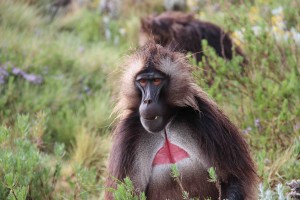
Geladas are strange monkeys. The females look rather like small olive baboons, but with thick, fluffy hair, and strange bare patches of red skin on their chest. The males look like little lions. They have long manes and tufted lion tails. Like females, they have bare red patches on their chests. They also have orange shadow all around their eyes, and when making threats, they raise their eyebrows to show off the orange.
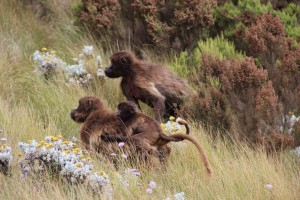
Baboons display lots of information about their reproductive status on their bottoms. Females have bright red swellings that indicate when they are ovulating, and a pregnancy sign that turns red when they have a baby on board. Geladas, though, spend much of the day scooting around on their bottoms, eating grass. A big swelling would get in their way while scooting, and you couldn’t see it anyway. So they display their reproductive condition on their chests instead. (They do get little swellings on their bottoms, just nothing as dramatic as baboons.)
In The Naked Ape, Desmond Morris argued that over the course of human evolution, a similar relocation of reproductive signals occurred. Just as in baboons, in our closer cousins, chimpanzees and bonobos, females signal ovulation with big swellings on their bottoms, suggesting that our common ancestor also may have had sexual swellings on their bottoms. Chimp swellings don’t look terribly comfortable or convenient, but as they mainly get around by walking on all fours, using their feet and knuckles, the swelling doesn’t get in the way much. With the evolution of a bipedal gait, however, the area that swells in chimps ended up between the legs, where a big swelling would make it hard to walk – and a small swelling would be hard to see. So, Morris argued, the main female visual signals, and corresponding male interest, shifted up from the bottom to the chest.
If Playboy published editions for chimps and baboons, they would feature lots of rear views. Playboy Gelada, however, would be all about the frontal shots.
Later, back at camp, I met a group of four bachelor males who were foraging in the grass just beyond the kitchen tent. If these were Gombe baboons, they would be racing into the kitchen tent to steal all our food. But gelada monkeys don’t seem to care about our food. They were content to skirt the camp, just looking for grass and herbs to eat.
At one point, I heard strange high-pitched calls coming from up the hill. The gelada bachelors noticed too – they looked up and stared towards the calls. Walking into camp, I found others looking up the hill. “Did you hear the wolves calling?” they asked.
So, just like when camping up in northern Minnesota, there’s a chance of hearing wolves here. But Ethiopian wolves are much smaller, and have a high-pitched whistling call, much different from the haunting howl of the gray wolf. Still, it was tremendously exciting to hear the call of these rare creatures, which only live in the Ethiopian highlands.


